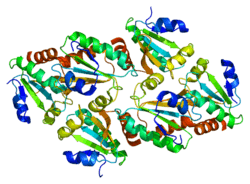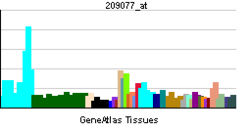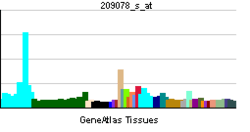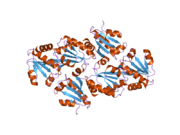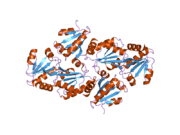TXN2
Thioredoxin, mitochondrial also known as thioredoxin-2 is a protein that in humans is encoded by the TXN2 gene.[1][2][3]
Function
This nuclear gene encodes a mitochondrial member of the thioredoxin family, a group of small multifunctional redox-active proteins. The encoded protein may play important roles in the regulation of the mitochondrial membrane potential and in protection against oxidant-induced apoptosis.[3] It has been shown that TGF-beta-mediated induction of HMGA2 was weakened by the expression of TXN2.[4]
Clinical Significance
It has been demonstrated that genetic polymorphisms in the TXN2 gene may be associated with the risk of spina bifida.[5]
References
- ↑ Spyrou G, Enmark E, Miranda-Vizuete A, Gustafsson J (Jan 1997). "Cloning and expression of a novel mammalian thioredoxin". The Journal of Biological Chemistry 272 (5): 2936–41. doi:10.1074/jbc.272.5.2936. PMID 9006939.
- ↑ Zhou J, Damdimopoulos AE, Spyrou G, Brüne B (Mar 2007). "Thioredoxin 1 and thioredoxin 2 have opposed regulatory functions on hypoxia-inducible factor-1alpha". The Journal of Biological Chemistry 282 (10): 7482–90. doi:10.1074/jbc.M608289200. PMID 17220299. Vancouver style error (help)
- ↑ 3.0 3.1 "Entrez Gene: TXN2 thioredoxin 2".
- ↑ Ishikawa F, Kaneko E, Sugimoto T, Ishijima T, Wakamatsu M, Yuasa A et al. (Jan 2014). "A mitochondrial thioredoxin-sensitive mechanism regulates TGF-β-mediated gene expression associated with epithelial-mesenchymal transition". Biochemical and Biophysical Research Communications 443 (3). doi:10.1016/j.bbrc.2013.12.050. PMID 24342608.
- ↑ Wen S, Lu W, Zhu H, Yang W, Shaw GM, Lammer EJ et al. (Feb 2009). "Genetic polymorphisms in the thioredoxin 2 (TXN2) gene and risk for spina bifida". American Journal of Medical Genetics. Part A 149A (2). doi:10.1002/ajmg.a.32589. PMID 19165900.
Further reading
- Wang Z, Zhang H, Li XF, Le XC (2007). "Study of interactions between arsenicals and thioredoxins (human and E. coli) using mass spectrometry". Rapid Communications in Mass Spectrometry 21 (22): 3658–66. doi:10.1002/rcm.3263. PMID 17939155.
- Udler M, Maia AT, Cebrian A, Brown C, Greenberg D, Shah M et al. (Jul 2007). "Common germline genetic variation in antioxidant defense genes and survival after diagnosis of breast cancer". Journal of Clinical Oncology 25 (21): 3015–23. doi:10.1200/JCO.2006.10.0099. PMID 17634480.
- Zhang H, Go YM, Jones DP (Sep 2007). "Mitochondrial thioredoxin-2/peroxiredoxin-3 system functions in parallel with mitochondrial GSH system in protection against oxidative stress". Archives of Biochemistry and Biophysics 465 (1): 119–26. doi:10.1016/j.abb.2007.05.001. PMID 17548047.
- Oestergaard MZ, Tyrer J, Cebrian A, Shah M, Dunning AM, Ponder BA et al. (Aug 2006). "Interactions between genes involved in the antioxidant defence system and breast cancer risk". British Journal of Cancer 95 (4): 525–31. doi:10.1038/sj.bjc.6603272. PMC 2360671. PMID 16868544.
- Cebrian A, Pharoah PD, Ahmed S, Smith PL, Luccarini C, Luben R et al. (Jan 2006). "Tagging single-nucleotide polymorphisms in antioxidant defense enzymes and susceptibility to breast cancer". Cancer Research 66 (2): 1225–33. doi:10.1158/0008-5472.CAN-05-1857. PMID 16424062.
- Collins JE, Wright CL, Edwards CA, Davis MP, Grinham JA, Cole CG et al. (2005). "A genome annotation-driven approach to cloning the human ORFeome". Genome Biology 5 (10): R84. doi:10.1186/gb-2004-5-10-r84. PMC 545604. PMID 15461802.
- Damdimopoulos AE, Miranda-Vizuete A, Pelto-Huikko M, Gustafsson JA, Spyrou G (Sep 2002). "Human mitochondrial thioredoxin. Involvement in mitochondrial membrane potential and cell death". The Journal of Biological Chemistry 277 (36): 33249–57. doi:10.1074/jbc.M203036200. PMID 12080052.
- Chen Y, Cai J, Murphy TJ, Jones DP (Sep 2002). "Overexpressed human mitochondrial thioredoxin confers resistance to oxidant-induced apoptosis in human osteosarcoma cells". The Journal of Biological Chemistry 277 (36): 33242–8. doi:10.1074/jbc.M202026200. PMID 12032145.
| |||||||||||||
